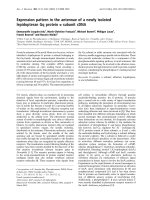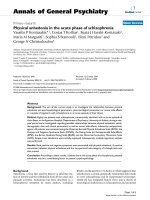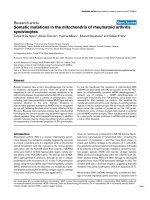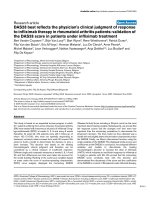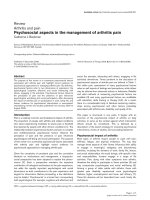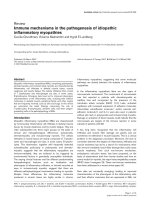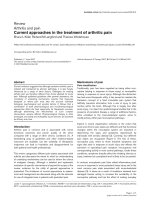Báo cáo y học: " Older patients in the ICU: a cautious analysis of epidemiologic data is required" ppt
Bạn đang xem bản rút gọn của tài liệu. Xem và tải ngay bản đầy đủ của tài liệu tại đây (105.23 KB, 1 trang )
Recently published in Critical Care, Roch and colleagues’
results have been extensively commented upon [1,2].
Indeed, such observational studies are necessary to im-
prove our understanding of ICU older patients’ outcome
[2]. We plead for cautious analysis of these epidemiologic
data, however, highlighting the following points.
Available studies are scarce, and are exposed to
selection bias. In France, the seven main cohort studies
exploring octo genarian patients’ outcome so far
published did not form a representative national sample
[1-3]. Among the 42 participating centers, 27 were
medical ICUs and 27 were located in teaching hospitals;
moreover, the hetero geneous case mix across centers
impaired meaningful comparisons [1-3].
Most of these data were collected several years ago,
over huge periods of time – for example, the French
cohorts were enrolled from 1991 to 1996 and from 2001
to 2006 [1-3]. e data were possibly biased by changes
in practice occurring during this time, such as changes in
triage and care recently reported in cohorts of ICU older
patients [3,4].
Finally, cross-national comparisons are sensitive,
exposed to cultural biases. Local end-of-life policies and
insurance policies can strongly infl uence ICU epidemi-
ology. Between the UK and the USA for example, the
ICU admission rate varies from 1.3% to 11% among the
older patients dying in hospital [5].
In order to improve the admission decision-making
process for ICU older patients, we call for large
multicenter cohort studies, followed over time, to obtain
an accurate and updated picture of this nuanced and
changing epidemiology. If we are to develop prognostic
scores on such studies, we need to pay special attention
to their design, to ensure their external validity.
Abbreviations
ICU, intensive care unit.
Competing interests
The authors declare that they have no competing interests.
Published: 27 April 2011
References
1. Roch A, Wiramus S, Pauly V, Forel JM, Guervilly C, Gainnier M, Papazian L:
Long-term outcome in medical patients aged 80 or over following
admission to an intensive care unit. Crit Care 2011, 15:R36.
2. McDermid RC, Bagshaw SM: Octogenarians in the ICU: are you ever too
old? Crit Care 2011, 15:125.
3. Lerolle N, Trinquart L, Bornstain C, Tadie JM, Imbert A, Diehl JL, Fagon JY,
Guerot E: Increased intensity of treatment and decreased mortality in
elderly patients in an intensive care unit over a decade. Crit Care Med 2010,
38:59-64.
4. Bagshaw SM, Webb SA, Delaney A, George C, Pilcher D, Hart GK, Bellomo R:
Very old patients admitted to intensive care in Australia and New Zealand:
a multi-centre cohort analysis. Crit Care 2009, 13:R45.
5. Wunsch H, Linde-Zwirble WT, Harrison DA, Barnato AE, Rowan KM, Angus DC:
Use of intensive care services during terminal hospitalizations in England
and the United States. Am J Respir Crit Care Med 2009, 180:875-880.
© 2010 BioMed Central Ltd
Older patients in the ICU: a cautious analysis of
epidemiologic data is required
Thomas Fassier* and Antoine Duclos
See related research by Roch et al., and related commentary by McDermid and Bagshaw,
/>LETTER
*Correspondence:
EAM 4128 Santé-Individu-Société, Faculté de Médecine Laënnec, Université Lyon
1, 7-11 rue G. Paradin, 69372 Lyon Cedex 8, France
doi:10.1186/cc10134
Cite this article as: Fassier T, Duclos A: Older patients in the ICU: a cautious
analysis of epidemiologic data is required. Critical Care 2011, 15:421.
Fassier and Duclos Critical Care 2011, 15:421
/>© 2011 BioMed Central Ltd
